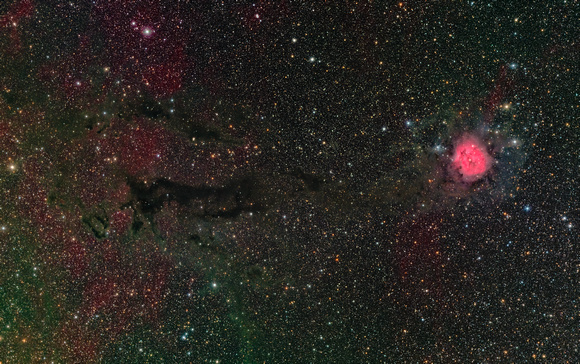Star Conception and Birth, The Cocoon and Associated Dark Nebula in LHaRGB
Cocoon (IC5146) and Associated Dark (B270) Nebulae - LHaRGB (Cygnus), June 2023
Televue 127is; AP Mach2
ASI6200MM, FIRST LIGHT - Baader CMOS-Opt Filters (L,R,G,B and Ha(6.5nm))
L: (40 x 160s exposures, Bin 1x1, Gain 100)
Ha: (20 x 720s exposures, Bin 1x1, Gain 100)
R,G,B: (20,20,20 x 180s, Bin 1x1, Gain 100)
Total Integration Time = 8.8 hours
This view of Cygnus is prototypical in a couple of ways. Compositionally, it contains a rich Milky Way starfield and faint hydrogen emission signal to provide the perfect backdrop to illustrate the three primary types of nebulosity. The Cocoon "Stellar Nursery" is bright with red hydrogen emissions, fueled by the UV emissions primarily from its bright, central infant star. Surrounding the Cocoon the same gas can be seen reflected light, mainly in blue, from other bright stars fairly close to the same gas. Throughout the image the gas is generally semi-transparent (ultra-low density), giving off at best a greyish glow. In certain areas, the gas is more dense and is visible only by the fact that it blots out the background glow and stars. This is the aptly named "dark nebulosity". All three forms of nebulosity are composed of essentially the same stuff - a hydrogen rich molecular dust cloud that is the sole ingredient to create new stars.
The image also shows two phases of star formation. The molecular cloud, which begins in a more homogeneous state, can be seen fragments and coalescing into dark nodules and losing its transparency in places. This is the effect of gravity that requires the gases to be very cold (and not jiggling about) to coalesce. Within the darkest nodules stars, protects from the warming light, stars are being concieved as the molecules continue to come together at discrete points. If sufficient material comes together in a cloud "nodule", a pro-star will be conceived and will continue to grow as gravitational effects on pulling material in will snowball.
Once large and hot enough, fusion will be ignited and a proper star will be born. This new born star will be rich in UV radiation which will heat, light up, and begin to blow away the gases surrounding it - creating an emission nebula such as the Cocoon. It can be seen that even within the Cocoon Nebula, there remains dark nodules, where gases are likely continuing to coalesce, protected from the heat and radiation of the new star by its opacity. Within these nodules, more stars will likely be created to form a star cluster and the molecular cloud will likely transform from a "stellar nursery" into a "star forming region"
Oh, and a shout out to Dan Posey - Thank you for setting up the GPU acceleration for Starnet et al - these complicated image processes now literally run in 1/16th the time.


